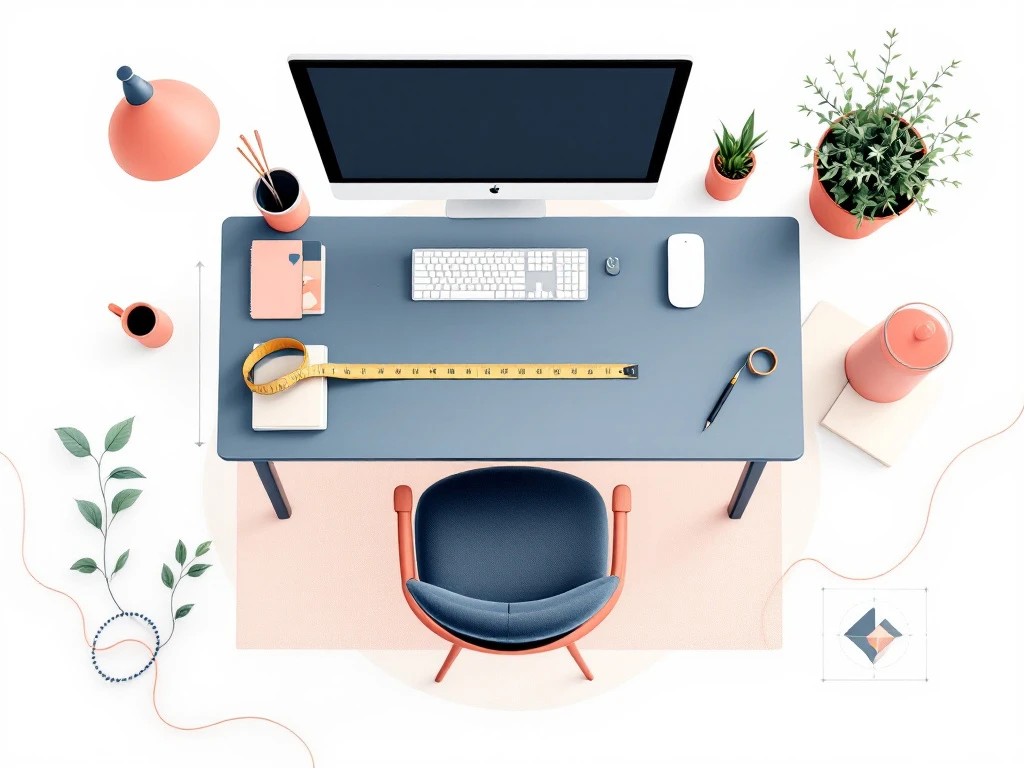For a functioning workstation, you need at least a 120 x 60 centimeter desk, surrounded by another 90 centimeters of free space for your office chair. This means that for a complete workstation you need about 4 to 6 square meters. The exact amount of space depends on your activities, the type of desk you choose and whether you share the space with others.
What are the minimum dimensions for a workstation?
A comfortable workplace starts with a desk of at least 120 centimeters wide and 60 centimeters deep. These dimensions give you enough room for a computer screen, keyboard, mouse and some work documents. For people who work a lot with papers or use multiple screens, a depth of 80 centimeters is better.
The height of your desk should be between 72 and 75 centimeters, depending on your height. Your elbows should be able to rest at a 90-degree angle when you type. Under the desk, you need at least 60 centimeters of width and 50 centimeters of depth for your legs.
Remember that your desk is part of a bigger picture. You also need space for your desk chair to move, stand up and sit. Therefore, count on at least 90 centimeters of free space behind your desk. This will ensure that you can work comfortably without feeling enclosed.
How many square feet do you need for a home office?
For a full-fledged home office, you ideally need between 6 and 10 square meters. This gives you enough space for a desk, desk chair, storage options and freedom of movement. In this space, you can work comfortably without feeling trapped.
Do you have less space available? A compact home office can be as small as 4 square meters. Think of a corner in the living room or bedroom with a smaller desk of 100 x 50 centimeters. The important thing is that you have a fixed workplace Creates where you can concentrate.
For those who regularly work from home and make video calls, a separate workroom of 8 to 12 square meters is ideal. This provides space for a larger desk, a bookcase, possibly a sitting area for breaks and enough distance from the background during video calls. A good home office contributes to your productivity and job satisfaction.
What is the difference between a sit and stand desk in terms of space?
A height-adjustable desk takes up about the same amount of floor space as a traditional desk, but it does require extra attention to its surroundings. The desks themselves are often slightly deeper (70-80 cm) because of the mechanism, and you need more free height, up to 120 centimeters for the highest position.
The main difference is in the room to move around the desk. With a standing desk, you move more and stand farther away from the desk. Count on at least 100 centimeters of free space behind the desk, instead of the 90 centimeters with a sit-down desk. You also need extra space for cable management, because the cables must move with the desk.
When placing a standing desk, also pay attention to wall outlets and windows. The desk should still be easily accessible in the highest position without cables getting too tight. A cable tray or coil can help keep everything neat while adjusting.
How do you calculate the right desk size for your work?
Start by mapping out everything that needs to be on your desk. Place your monitor, keyboard, mouse and other daily necessities on the table and measure how much space this takes up. Add 20 to 30 inches of work space for documents and notes.
Different guidelines apply to different activities:
- Computer work: minimum 120 x 60 cm
- Creative work with drawing: minimum 140 x 80 cm
- Work with multiple screens: at least 160 x 80 cm
- Administrative work with many papers: minimum 140 x 70 cm
Also consider future needs. Are you perhaps going to purchase an additional screen? Are you working more and more with physical documents? If so, choose a desk that is slightly larger than your current needs. A desk that is too small leads to frustration and decreased productivity.
What extra space do you need around your desk?
Around your desk, you need several zones for comfortable working. Directly behind your desk chair should be at least 90 centimeters of free space be to easily stand up and sit down. On the sides of your desk, 60 centimeters is sufficient for passage.
If your desk is against a wall, provide at least 10 inches of space between desk and wall. This prevents damage and gives room for cables. For a freestanding desk in a room, you need at least 80 centimeters all around for good accessibility.
Don't forget the walking routes, either. From your desk to the door, printer or other important points, you should be able to walk freely without obstacles. A walking route at least 80 centimeters wide is comfortable. For wheelchair users or people with mobility aids, 120 centimeters is better. This extra space may seem like a lot, but it contributes immensely to your working comfort.
What are smart solutions for small workspaces?
In small spaces, you can still create a full-fledged workspace with smart furniture. A wall desk or folding table takes up no floor space and can be folded away after working hours. These solutions are perfect for studios or small apartments where every square foot counts.
Vertical storage is your best friend in a small workspace. Use the walls for shelves, magnetic boards or storage systems. A desk with built-in drawers saves space for a separate chest of drawers. Choose furniture with multiple functions, such as a pouf with storage that doubles as extra seating.
Other smart tips for small spaces:
- Use a corner desk to take advantage of dead corners
- Choose a laptop instead of a desktop to save space
- Hang your lighting on the wall or ceiling instead of a desk lamp
- Use transparent or light furniture to make the space optically larger
For those who regularly work in different spaces or seeks flexible office solutions, a mobile desk on wheels can help.
How do you set up a shared workspace efficiently?
In a shared workspace, it is important to respect everyone's personal zone. Plan at least 4 square meters per person, with clear boundaries between workstations. This can be done with low partitions, planters or even just by the arrangement of desks.
Create different zones for different activities. A quiet zone for concentrated work, a collaboration zone for consultation and a relaxation corner for breaks. Make sure these zones flow logically into each other without interfering with each other. Acoustic solutions such as sound-absorbing panels help reduce noise pollution.
Flexibility is essential in shared spaces. Choose desks that are easy to move and chairs that are height adjustable. Provide plenty of electrical outlets and, if necessary, use cable ducts to neatly hide cords. A clean desk policy, where everyone cleans up their workspace at the end of the day, keeps the space pleasant for everyone.
Conclusion: The perfect workspace for your situation
The ideal desk space varies by person and situation. For a basic home office, you need at least 4 square meters with a 120 x 60 centimeter desk. If you work full-time from home or have specific duties, 6 to 10 square meters is more comfortable. Most importantly, your workspace should fit your work style and daily activities.
Remember these key points when setting up your workspace: make sure you have enough freedom of movement around your desk, choose the right desk size for your work and make smart use of small spaces with multifunctional solutions. A well-organized workspace significantly increases your productivity and job satisfaction.
Sometimes a home office is not the best solution. Do you need work-life separation, more professional facilities or the company of other professionals? Then flexible workspaces like those offered by Co-Office offer an excellent solution. With fully equipped workstations, meeting rooms and an inspiring work environment, you can get started right away. Want to know more about the possibilities for your situation? Then take contact with us for a free consultation.

